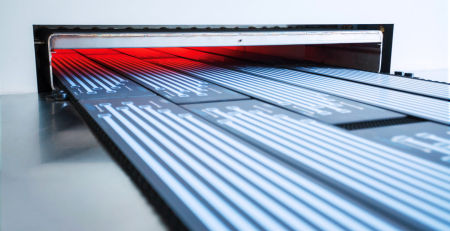Customer requirements:
Our customer was faced with the challenge of making the roll change of a fleece fabric more efficient and safer. He had been using a sewing machine to join the ends of a two-meter-wide fleece roll. The machine had to be stopped for the manual process. The process is also prone to errors, as the needle can break and has to be replaced manually, which poses a risk of injury to employees.
Another problem was that a broken needle makes the fabric unusable, the search for it is very time-consuming and involves an unscheduled, lengthy machine stop.
The customer’s aim was to enable a reliable and fast roll change without having to stop the machine. As the further transport takes place via turning rollers, the seam must not be too wide and tight, as this could cause problems during material transport.
Our solution:
To create a thin seam, we developed a RESISTRON tool with a narrow heat-sealing band and a matching backing with a flat silicone profile.
A flat splicer is used to join the ends of the rollers. Here, the respective ends of the rolls are placed on top of each other and joined together by the heat input of the sealing tools. This process minimizes the excess material so that the fleece web does not get stuck during further transport.
Thanks to the rapid heating and cooling of the tools and the low heat input, the sealed seam is immediately resilient and stable for further processing in the machine.
The change in technology reduces unscheduled faults for the customer, as no parts are used that could break off. The customer also benefits from a homogeneous seam surface over the entire length and ensures that the roll change is efficient, timesaving and resource-saving.
Customer advantage:
1. Product safety: As there is no need to search for a broken needle in the fleece.
2. Time saving: Compared to conventional sewing techniques, especially when joining two rolls with a web width of two meters, impulse sealing offers a significantly faster process.
3. Reproducible sealing results: – Ensuring consistent heat input with every cycle, resulting in reproducible seam quality.
4. Homogeneous temperature distribution: The uniform temperature distribution on the heat-sealing band surface of our tools results in consistent seam quality over the entire seam length.
5. Rapid heating: RESISTRON technology enables the sealing tool to heat up quickly, making the tools ready for immediate use.
6. Rapid cooling of the tool: The tool cools down within a few seconds, resulting in short waiting times in the event of repairs. This reduces machine downtime and minimizes the risk of injury to personnel.
7. Low energy consumption: Energy consumption is low as the sealing tool is only heated during the sealing process. This leads to an efficient and resource-saving use of energy.





